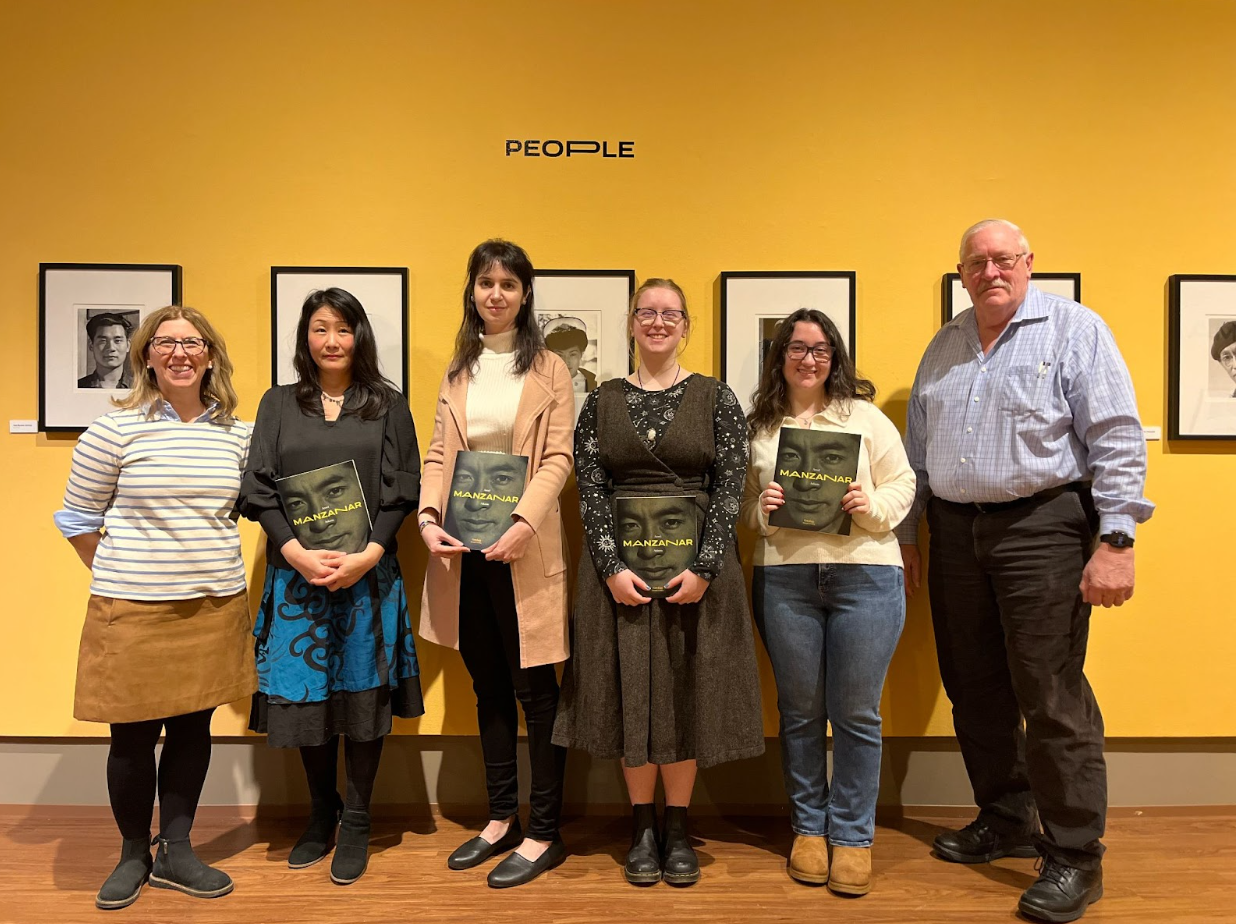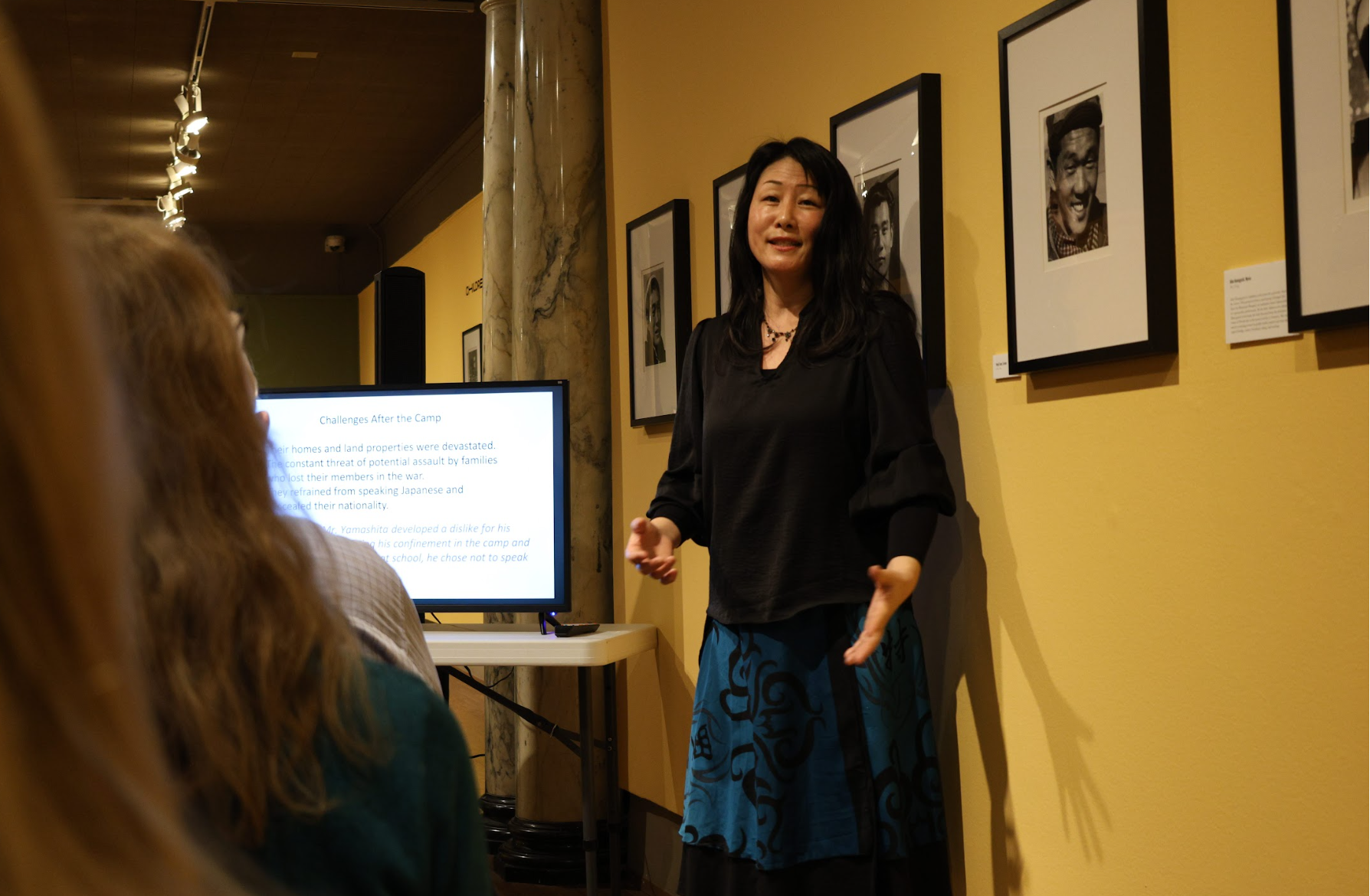
The group that worked on the panel, including student curators Emma Wylam ’24 and Sophia Crawford ’24. (Photo Chloe Kieper/The Gettysburgian)
By Chloe Kieper, Contributing Writer
The Eisenhower Institute cohosted a Lunch and Learn Panel on the Manzanar War Relocation Center with the Schmucker Art Gallery on Wed. The panel was headed by Professor of Asian Studies Yoko Nishimura and Professor of Political Science Alauna Safarpour. The panel covered the history behind Schmucker Art Gallery’s first art exhibition of 2024 titled “Ansel Adams: Manzanar,” which was curated by Emma Wylam ’24 and Sophia Crawford ’24 under Interim Gallery Director Sarah Gillespie.
To begin, Safarpour gave an explanation of immigration laws and naturalization affecting Japanese Americans following the 1922 Supreme Court decision, Ozawa v. United States, which excluded Japanese immigrants from naturalization because they had a non-white status. Safarpour continued to explain Former United States President Franklin D. Roosevelt’s Executive Order 9066, stating that “the order was aimed to curb potential espionage [and] move all the people who were deemed a threat to these relocation centers or internment camps.”
This order targeted Japanese Americans following the bombing of Pearl Harbor. An important event that Safarpour noted was that the Supreme Court ruled during this time that “the rights of American citizens can be infringed during times of war in order to curb and guard against potential espionage.”
Safarpour discussed topics such as racial profiling and reparations for Japanese Americans, as well as the treatment of other minority groups such as Middle Eastern Americans, Native Americans and Black Americans. She concluded her section of the panel with a discussion of reparations for minority groups, including Japanese Americans. Safarpour spoke on the activism of Japanese American groups fighting for the interests of minority groups in recent years.
Nishimura’s discussion shifted to Japanese American experiences in internment camps, focusing more on information from newspaper articles, memoirs and personal anecdotes. A theme throughout Nishimura’s discussion was the difficulties faced by Japanese immigrants to the United States. Nishimura spoke on the experience of several women who faced identity loss as they struggled with their Japanese and American identities. In particular, Nishimura spoke about the story of a woman named Miss Okazaki, who was in Manzanar at the age of seven.
Nishimura stated, “Miss Okazaki recalls feeling embarrassed in the cramped room where makeshift beds were crowded together and the privacy-lacking restroom.”
The influence and importance of loyalty questionnaires imposed on those in internment camps were also discussed. These questionnaires made Japanese Americans confused about their loyalties and place in the world, affecting both native-born Japanese people who immigrated to the United States, as well as the second-generation Japanese Americans who had lived there for their entire lives.
Another Japanese American woman had said, “We were born in America, but we were not really American citizens.”
A question on the loyalty questionnaire asked “Will you forswear any form of allegiance or obedience to the Japanese Empire?” The panel discussed how the problematic nature of this question is that Japanese Americans born in the United States did not have any allegiance to the Japanese Empire, so they could not promise to reject allegiance to a nation that they did not possess.
Japanese immigrants who had not obtained United States citizenship also expressed reluctance and uncertainty as they would feel stripped of their Japanese nationality and identity, thus being nationless. Nishimura spoke on the personal experiences and reactions Japanese Americans had while in internment camps and their resulting loss of Japanese identity and erasure of culture.
Following the talks from the faculty panelists, guests, including students and faculty, asked various questions on the subject. The exhibit on Ansel Adams and his documentation of the Japanese internment camp will be open until April 13.
(Editor’s Note: This article was edited at 10:37 a.m. on Feb. 23, 2024 to clarify that the event was cohosted by the Eisenhower Institute and the Schmucker Art Gallery. – L. Franchetti)

The panel discusses the Manzanar War Relocation Center in the Schmucker Art Gallery. (Photo Grace Jurchak/The Gettysburgian)



